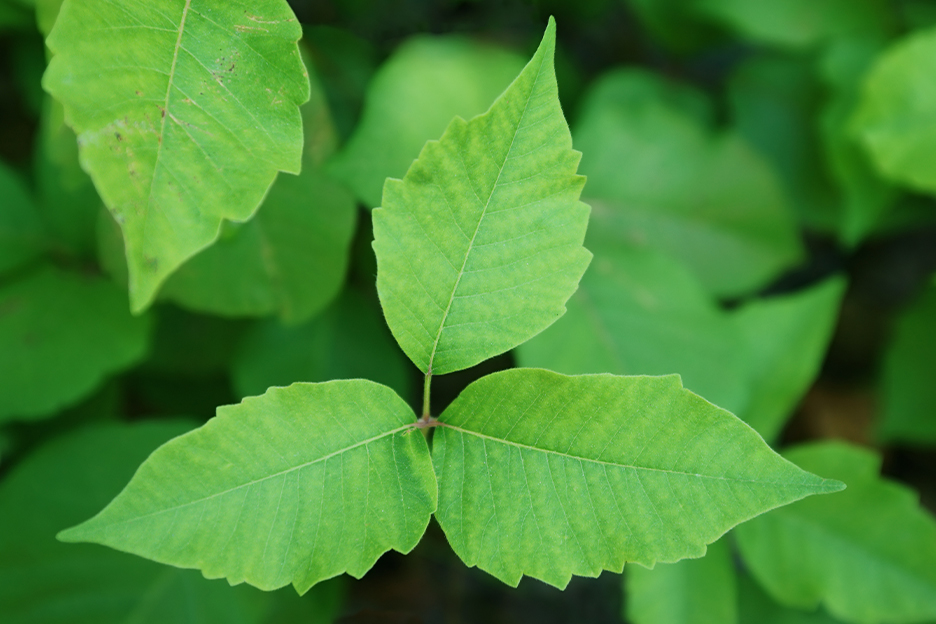You’ve probably heard the old adage “leaves of three, let it be.” This saying refers to poison ivy, a widespread plant in North America that causes itching on contact.
But what exactly is poison ivy? How do you identify it? What are the symptoms and how do you treat them? How do you get rid of it?
Let’s take a closer look.

What is poison ivy?
Poison ivy (Toxicodendron radicans) is a poisonous weed that can cause severe inflammatory reactions on the skin after contact.
Poison ivy is common in Canada and grows mainly on uncultivated land, notably in ditches, along roadsides, and on wooded trails. This tenacious plant can also grow on sandy or rocky shores and on agricultural or residential properties. It can spread by seed or via its extensive network of underground stems.
How do you identify it?
Though there are several different types of poison ivy, the plant can generally be identified by its characteristic shiny green leaves that grow in clusters of three. They are oval in shape and may have smooth or notched edges. The stems can grow in climbing vines, as dense shrubs, or along the ground.
In June and July, the plant often produces small greenish or cream-coloured flowers. In winter, poison ivy usually loses its leaves and may appear dead. The stems look dry and the plant blends in with the surrounding vegetation. However, despite their appearance, the stems and roots can still cause reactions in those who come into contact with the plant.
Did you know that poison ivy can still cause painful symptoms even when it’s dead? The poisonous resin it contains can stay active on surfaces for up to five years.
What symptoms appear after contact with poison ivy?
First, it’s important to understand that the plant’s oily sap is what causes a rash on contact. It contains a toxic substance called urushiol. Every part of the poison ivy plant, including the leaves and roots, contains urushiol. Contact with this toxin can cause unpleasant symptoms, such as the following:
- Redness
- Intense itching
- Swelling
- Blisters
- Pain
- A sensation of warmth or burning
These symptoms may be more intense if the affected person is more sensitive to urushiol or has been exposed to a large quantity of sap. Symptoms generally appear within 24 to 48 hours of direct contact with poison ivy, contact with an object or pet contaminated with the sap, or exposure to the smoke produced when the plant is burned.
Important!
You should never burn poison ivy, as inhaling the smoke can cause painful inflammation of the lungs and severe respiratory issues. Moreover, burning the plant may disperse its seeds and cause it to spread.
Although the rashes caused by poison ivy are not contagious, if a person still has traces of urushiol on their skin or clothing after contact with the plant, the oil can spread and cause reactions in other people.
Do the symptoms go away on their own?
The symptoms caused by exposure to poison ivy tend to clear up on their own after a few weeks, though it may take longer depending on the severity of the reaction. Here’s how to relieve poison ivy symptoms:
- Apply cold compresses for 15 to 30 minutes a few times a day.
- Avoid taking hot baths and showers, as hot water can make redness, itching, and swelling worse.
- Avoid aggressively scratching or rubbing the area. Doing so can make the rash worse and increase the risk of infection.
- Apply an over-the-counter cream containing corticosteroids or a soothing lotion such as calamine. A pharmacist can help you choose the right product.
Consult a professional if your rash becomes infected, your symptoms don’t improve, or the rash covers a large area of your body.
What should I do if I come into contact with poison ivy?
If you come into contact with poison ivy, here’s what you can do to limit your reaction:
- Immediately wash the affected area with soap and cold water. Do not use hot water, as it dilates the pores and increases the chances of the urushiol being absorbed into your skin.
- If your clothes have come into contact with the plant or a contaminated object, take them off and wash them immediately to avoid spreading the resin.
- Do not rub or scratch the affected area, as this may worsen your symptoms and further spread the urushiol.
- Keep an eye on your symptoms. If you notice any severe symptoms, contact a health professional.
Good to know
If your pet gets into some poison ivy, don’t worry—they won’t develop symptoms as long as they didn’t ingest it. However, pets can carry the sap on their fur or paws, so you should take precautions to prevent them from spreading it. Give your pet a thorough bath, taking care not to come in direct contact with the urushiol.
For advice or more information on poison ivy, don’t hesitate to talk to your pharmacist.
Posted on July 3, 2024
Learn more about how to make the most of summer
5 strategies to enjoy outdoor activities despite allergies
Protecting yourself from the sun’s rays
